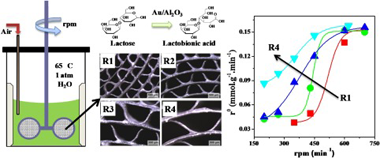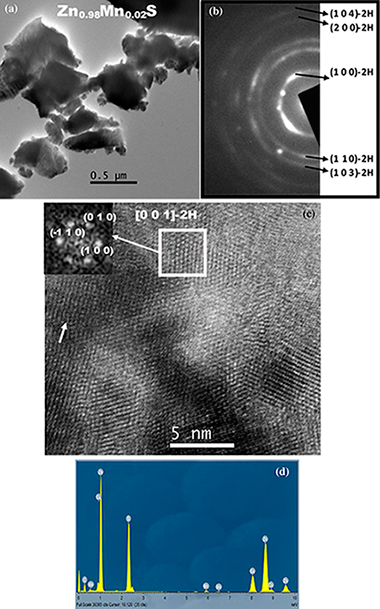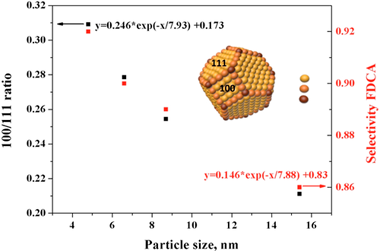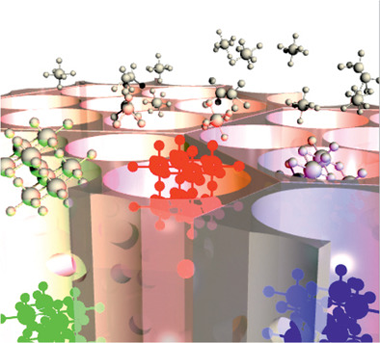Scientific Papers in SCI
2020
2020
Fotocatálisis Heterogénea: Aplicaciones
Hybrid ZnO/Ag3PO4 photocatalysts, with low and high phosphate molar percentages
Martín-Gómez, A.N.;Navío, J.A.;Jaramillo-Páeza, C.;Sánchez-Cid, P.;Hidalgo, M.C.Journal of Photochemistry and Photobiology A: Chemistry, (2020) 112196

In this work, a previously optimized synthesized ZnO photocatalyst was modified with different molar percentages of Ag3PO4 through a facile in situ precipitation–deposition method and then characterized by different techniques (XRD, XRF, BET, UV–vis DRS, SEM, TEM and XPS). The incorporation of Ag3PO4 produces important changes in the light absorption properties with a significant absorbance in the visible region observed for ZnO modified with different amounts of Ag3PO4; the optical absorption intensity in the visible region of the coupled ZnO/Ag3PO4 increases as the molar percentages of Ag3PO4 increases, evidencing a clear dependence on the content of Ag3PO4. However, this work shows that the incorporation of Ag3PO4 in almost all cases reduces the photocatalytic capacity of ZnO, except when it is used in a specific percentage of 10 % and only being more active against rhodamine B and not on the Caffeine. SEM images and elemental mapping indicate that Ag3PO4 disperses very well in the ZnO particles, exhibiting an almost homogeneous distribution, showing zones with cumulus of Ag3PO4 (rich in P-Ag) in contact with ZnO-zones (rich in Zn). All the prepared photocatalysts were tested in the photocatalytic degradation of rhodamine B as a dye, and caffeine as a toxic and persistent emerging compound under UV and visible light illumination. It is reported that not only the ZnO:Ag3PO4 ratio is an important factor that influences the photocatalytic process of substrate degradation, but also the nature of the substrate has an important influence on the photocatalytic behavior of the materials under both UV and visible illumination. Thus, pristine Ag3PO4 showed high photocatalytic degradation for rhodamine B, while for caffeine negligible photocatalytic degradation was found in both the UV and visible regions. The thermal- and photo-stability of the coupled system was also studied. At least, for rhodamine B no loss of photocatalytic activity has been observed after five recycles although the mineralization degree progressively diminished along the recycles.
February, 2020 | DOI: 10.1016/j.jphotochem.2019.112196
Química de Superficies y Catálisis
Modulation of the acidity of a vermiculite and its potential use as a catalytic support
Amaya, J; Bobadilla, L; Azancot, L; Centeno, M; Moreno, S; Molina, RJournal of Materials Science, 55 (2020) 6482-6501
The modulation and characterization of the acidity of a vermiculite were carried out, which was modified by delamination by means of hydrothermal and acid treatments with the subsequent incorporation of AlZr and AlCe species to modulate the acidity. The effect of these species was evaluated regarding the structural (XRD, XPS and IR), textural (N-2 sortometry) and acidity properties (NH3-TPD, NH3-DRIFTS and CO adsorption at low temperature). The catalytic performance was studied in the dehydration-dehydrogenation reactions of 2-propanol and the hydroconversion of decane, which generate important information about the acidity properties such as the type, number and strength of acidic sites. The correlation between the number, type and acid strength with the catalytic behavior allowed to establish the important effect regarding the nature of the mineral, its method of delamination and the nature of the incorporated cation, thus generating tools for controlled processes for the potentiation of the acidity of new supports from raw vermiculite.
February, 2020 | DOI: 10.1007/s10853-020-04445-5
Nanotecnología en Superficies y Plasma
Robust label-free CuxCoyOz electrochemical sensors for hexose detection during fermentation process monitoring
Lopez-Fernandez, E; Gil-Rostra, J; Espinos, JP; Gonzalez, R; Yubero, F; de Lucas-Consuegra, A; Gonzalez-Elipe, ARSensors and Actuators B-Chemical, 304 (2020) 127360

Label free electrochemical sensors of glucose are used whenever long-term operation and stable response are required. For this purpose, various metals and oxides of the first transition series have been proposed as alternative to more expensive noble metal electrochemical sensors. In this work we propose a new formulation consisting of copper-cobalt mixed oxides which, in the form of porous and nanostructured thin films with well controlled Co/Cu ratio, are prepared at room temperature in one step by a modification of the magnetron sputtering oblique angle deposition procedure. Films with various compositions were electrochemically characterized by cyclic voltammetry to determine their amperometric response to glucose as a function of voltage and NaOH electrolyte concentration. This analysis showed that films with a Co/Cu atomic ratio equal 3.4 presented a maximum sensitivity (0.710 A M−1 cm−2), a small limit of detection (0.105 μM) and a resilient behaviour upon cycling operation and long storage periods that clearly overpassed the performance of copper and cobalt single oxides. The CuxCoyO electrocatalysts also presented a good selectivity towards glucose and fructose in the presence of common interference compounds found in biological fluids (e.g., ascorbic acid, acetaminophen and uric acid), sucrose and ethanol, this latter present in many agrofood liquids. The possibilities of this sensor electrocatalyst have been tested for the analysis of a wine synthetic fermentation process. The comparison of the electrochemical results with conventional analytical methods showed a lineal amperometric response with respect hexose contents in a must at different stages of its transformation into wine.
February, 2020 | DOI: 10.1016/j.snb.2019.127360
Química de Superficies y Catálisis
Recent advances in selective oxidation of biomass-derived platform chemicals over gold catalysts
Megias-Sayago, C; Navarro-Jaen, S; Castillo, R; Ivanova, SCurrent Opinion in Green and Sustainable Chemistry, 21 (2020) 50-55

Gold is without a doubt the best known metal for chemical oxidation. The noblest of the noble metals gained its place because of its resistance to overoxidation, low temperature of operation, especially in gas-phase oxidation, and fairly good selectivity when required. The aim for sustainable development and the need for new technologies open the possibility to introduce new raw materials and new catalyst formulation. That is why new horizons appear in the otherwise uncertain future of gold catalysis. The old glory becomes now a glorious alternative, and this mini-review gives only a small example of it.
February, 2020 | DOI: 10.1016/j.cogsc.2019.12.001
Fotocatálisis Heterogénea: Aplicaciones
Role of Fe(III) in aqueous solution or deposited on ZnO surface in the photoassisted degradation of rhodamine B and caffeine
Tanji, Karim; Navio, J A; Martin-Gomez, A N; Hidalgo, M C; Jaramillo-Paez, C; Naja, Jamal; Hassoune, Hicham; Kherbeche, AbdelhakChemosphere, 241 (2020) 125009

Iron (III) was incorporated, to the surface of a synthesized ZnO, using two nominal molar percentages of Fe (III): 1% and 5% Fe relative to ZnO. Samples dried and calcined at 200 °C and 400 °C for 2 h, were characterized by XRD, XPS, XRF, N2-adsorption-BET and (UV–vis)-DRS. Photocatalytic activities of the catalysts were assessed based on the degradation of rhodamine B (RhB) and caffeine (CAF) in aqueous solution under two irradiation conditions: UV and visible light illumination. Prior to the photocatalytic tests, the interaction of each one of the substrates with either Fe(III) or Fe(II) was studied in homogeneous medium under UV-illumination and oxygenated environment. It was found that Fe (III) can play an important role in homogeneous media in the photoassisted degradation, both of rhodamine B and caffeine, while Fe (II) does not exert a relevant role in the photoassisted degradation of the referred substrates. Fe–ZnO samples display similar or poorer performance than pure ZnO in the presence of UV light for both studied substrates. The phenomenon can be attributed to the formation of either goethite or ZnFe2O4 at the ZnO surface where the coupled Fe3+/Fe2+ can act as recombination centers for the photogenerated charges. On the contrary, all Fe–ZnO samples showed enhanced photocatalytic activity under visible illumination which seems to be independent of the iron content. In this context, the mechanisms for photoassisted degradation of both the substrates in homogeneous medium and photocatalytic degradation are discussed, as well as the role of Fe in the photodegradation processes.
February, 2020 | DOI: 10.1016/j.chemosphere.2019.125009
Química de Superficies y Catálisis
Monolithic stirrer reactor: The selective lactose oxidation in liquid phase over Au/Al2O3 nanostructured catalysts
Regenhardt, SA; Meyer, CI; Sanz, O; Sebastian, V; Ivanova, S; Centeno, MA; Odriozola, JA; Montes, M; Marchi, AJ; Garetto, TFMolecular Catalysis, 481 (2020) 110219

The performance of rotating metallic monolith stirrer reactor was studied for selective lactose oxidation in liquid phase at 65 degrees C, atmospheric pressure and with air as oxidant agent. The Au/Al(2)O(3)deposition on metallic substrates was performed by wash-coating, producing catalyst coating thicknesses between 5 and 20 mu m. Monoliths with different configuration (channel size between 0.36 and 1.06 mm) were used as stirrer blades in a batch reactor. Internal and external mass transfer limitations were observed during liquid phase lactose oxidation. For stirring rates equal or higher than 600 rpm there were no important external diffusional restrictions and this was also independent of the monolith configuration. Coating with thickness higher than 15 mu m presents loss of catalyst effectiveness due to internal diffusional restrictions. Excellent stability in the catalytic tests was obtained after three regeneration-reaction cycles. Regeneration was carried out at 400 degrees C in air flow. Gold particle size distribution in the monolith washcoat, determined by TEM before and after reaction, was homogeneous with a medium size of around 5 nm. This is in agreement with the very good reproducibility and stability obtained in the catalytic tests. After calcination at 500 degrees C, some sintering and a heterogeneous distribution of metal particle size was observed, accompanied by a slight loss in catalyst activity. It is concluded that metallic monolith stirrer reactors are a promising application for selective lactose oxidation in liquid phase.
February, 2020 | DOI: 10.1016/j.mcat.2018.10.014
Reactividad de Sólidos
Synthesis of Mn2+-doped ZnS by a mechanically induced self-sustaining reaction
Aviles, MA; Cordoba, JM; Sayagues, MJ; Gotor, FJJournal of Materials Science, 55 (2020) 1603-1613

The mechanochemical process denoted as a mechanically induced self-sustaining reaction was successfully applied in obtaining Mn-doped ZnS samples with Mn content between 0 and 5 mol%. The process consists in milling Zn/Mn/S powder elemental mixtures with the appropriate stoichiometry, which promotes after approximately 80 min the induction of a combustion reaction. The doping level was properly adjusted by controlling the atomic ratio of the starting mixture. A complete characterization of samples was carried out, including X-ray diffraction, high-resolution transmission electron microscopy, selected area electron diffraction, energy-dispersive X-ray spectroscopy, Raman spectroscopy, diffuse reflectance UV-Vis spectroscopy and emission and excitation photoluminescence measurements. A wurtzite structure, in which Mn2+ replaces Zn2+, was obtained with a nanometric character. The photoluminescence of samples showed the characteristic (Mn2+T1)-T-4-(6)A(1) emission that was highly dependent on the doping level. The maximum luminescence efficiency through the ZnS excitation was found for a doping value of 1 mol%. The photoluminescence showed virtually no contribution from the host emission, which confirmed that samples were properly doped.
February, 2020 | DOI: 10.1007/s10853-019-04138-8
Química de Superficies y Catálisis
Catalytic Performance of Bulk and Al2O3-Supported Molybdenum Oxide for the Production of Biodiesel from Oil with High Free Fatty Acids Content
Navajas, A; Reyero, I; Jimenez-Barrera, E; Romero-Sarria, F; Llorca, J; Gandia, LMCatalysts, 10 (2020) 158
Non-edible vegetable oils are characterized by high contents of free fatty acids (FFAs) that prevent from using the conventional basic catalysts for the production of biodiesel. In this work, solid acid catalysts are used for the simultaneous esterification and transesterification with methanol of the FFAs and triglycerides contained in sunflower oil acidified with oleic acid. Molybdenum oxide (MoO3), which has been seldom considered as a catalyst for the production of biodiesel, was used in bulk and alumina-supported forms. Results showed that bulk MoO3 is very active for both transesterification and esterification reactions, but it suffered from severe molybdenum leaching in the reaction medium. When supported on Al2O3, the MoO3 performance improved in terms of active phase utilization and stability though molybdenum leaching remained significant. The improvement of catalytic performance was ascribed to the establishment of MoO3-Al2O3 interactions that favored the anchorage of molybdenum to the support and the formation of new strong acidic centers, although this effect was offset by a decrease of specific surface area. It is concluded that the development of stable catalysts based on MoO3 offers an attractive route for the valorization of oils with high FFAs content.
February, 2020 | DOI: 10.3390/catal10020158
Química de Superficies y Catálisis
Effect of Gold Particles Size over Au/C Catalyst Selectivity in HMF Oxidation Reaction
Megias-Sayago, C; Lolli, A; Bonincontro, D; Penkova, A; Albonetti, S; Cavani, F; Odriozola, JA; Ivanova, SChemcatchem, 12 (2020) 1177-1183

A series of gold nanoparticles in the 4-40 nm range were prepared, immobilized on activated carbon and further tested, at low base concentration, in the catalytic oxidation of 5-hydroxymethyl furfural (HMF) to 2,5-furandicarboxylic acid (FDCA). Gold particles size variation has no influence on HMF conversion but significantly affects product selectivity and carbon balance. This behavior is ascribed to the thermodynamically favorable oxygen reduction reaction on Au(100) faces. As the gold particle size decreases the Au(100)/Au(111) exposure ratio, estimated by using the van Hardeveld-Hartog model, increases as well as the FDCA selectivity. The smaller the gold particle size the smaller the 5-hydroxymethyl-2-furancarboxylic acid (HMFCA) to FDCA ratio pointing to the gold size dependent behavior of the oxidation of the alcohol function of the HMF molecule.
February, 2020 | DOI: 10.1002/cctc.201901742
Materiales Ópticos Multifuncionales
Mesoporous Matrices as Hosts for Metal Halide Perovskite Nanocrystals
Rubino, A; Calio, L; Garcia-Bennett, A; Calvo, ME; Miguez, HAdvanced Optical Materials, (2020) 201901868

Several works have recently demonstrated that perovskite nanocrystals can be controllably formed within a variety of porous matrices employing diverse synthetic strategies. By means of the fine tuning of the pore size distribution, the thickness and composition of the walls, the geometry of the void network and its topology, strict control over the structural and morphological parameters of the hosted semiconductor can be achieved, determining its optical absorption and emission properties. Furthermore, porous hosts provide the guest semiconductor with enhanced stability and versatility in terms of processing, which favors its integration in devices. This article provides a comprehensive review of the different approaches proposed, as well as a discussion on the relevance they may have for the development of nanostructured perovskite-based optoelectronics. A critical assessment of the optical quality of the hybrid perovskite nanomaterials so obtained is presented, as well as an analysis of the fundamental and applied aspects of the nanocrystal-matrix interaction and a projected prospect of their impact in the fields of artificial lighting and renewable energy.
February, 2020 | DOI: 10.1002/adom.201901868
- ‹ previous
- 62 of 214
- next ›














